6th Street Facade of One Financial Building is Retail Ready
In November I suggested that Stifel missed an opportunity for good urbanism by putting a sculpture at Broadway & Washington corner of their building, One Financial, rather than corner a corner retail space. Here’s how the corner looks now:
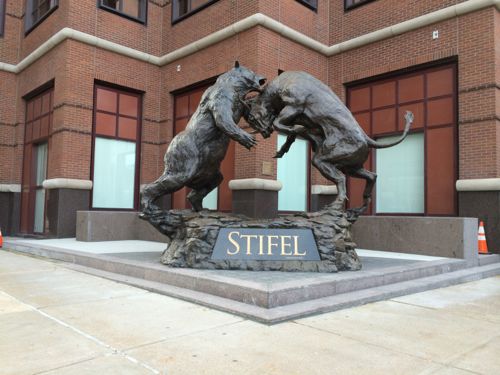
I finished that post with “They can still create an active corner on the west side, at 6th — facing MetroLink.” I still wish something more active was on the front corner, but the 6th Street side is made for retail.
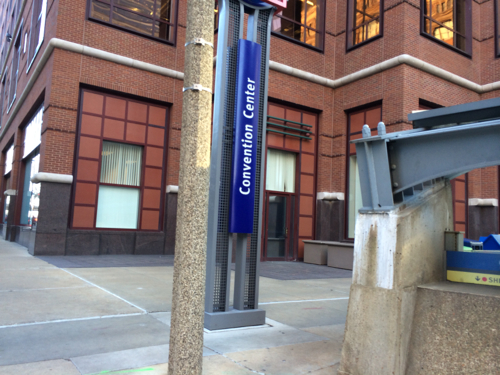
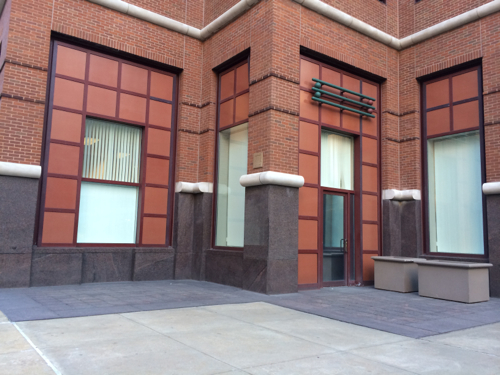
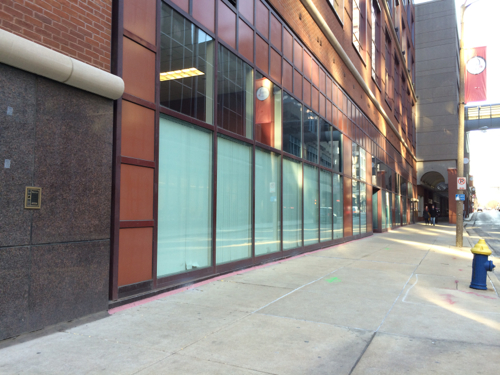
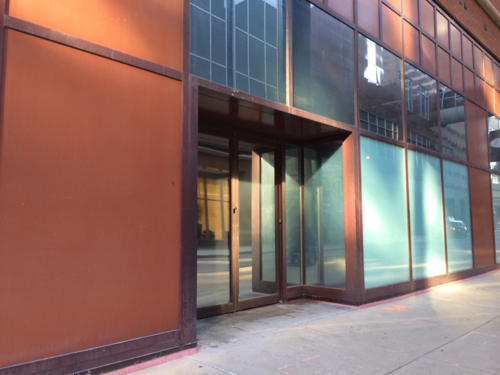
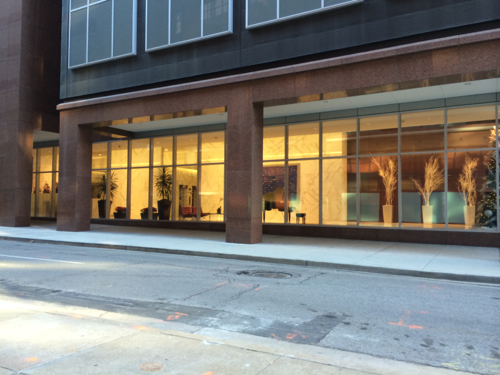
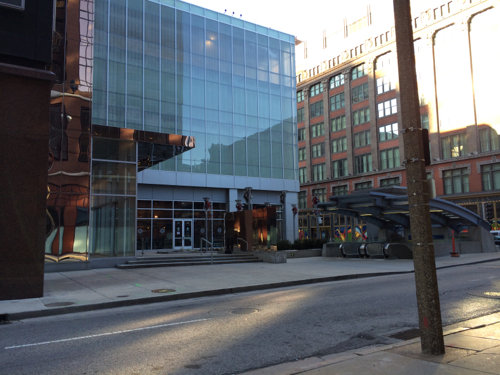
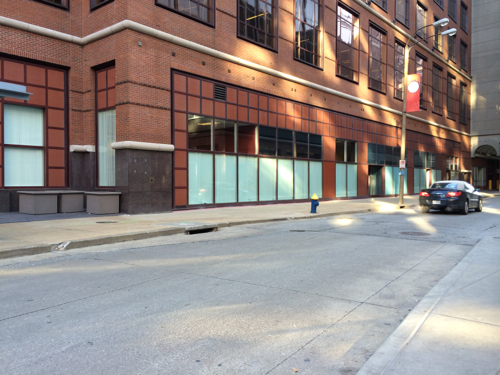
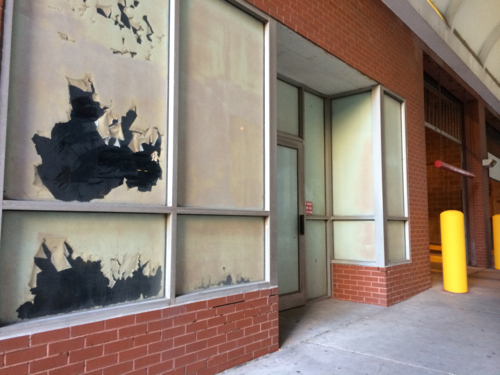
I’m very aware there’s already lots of vacant retail space available, but this large space in One Financial has great visibility at a corner busy with locals and visitors: location, location, location! Retailers looking for the right space are going to hire a commercial broker to search listings to find the right location, it it’s not listed they’re not going to consider it.
I’d much rather see a “retail space for lease” sign than closed office blinds. Stifel needs to relocate anyone in this space to another floor in the building and get this space on the market.
— Steve Patterson
So, let me get this right . . . you want a property owner who has a tenant occupying most, if not all, of a building, in a market where vacancies are running 20%, “to relocate anyone in this space to another floor in the building and get this space on the market.”?! Moving tenants takes money, marketing vacant space takes money, fitting out the space for a new tenant takes money. Landlords are in business to keep spaces filled and to make money, not to create new vacancies, in the “hope” of attracting new tenants, while not making money!
Is this the highest and best use for the space? Is it what it was originally designed for? No! But, unlike many other “retail” spaces downtown, it IS currently occupied and generating revenue. Once Stiffel decides that it no longer needs the space, then it will be the time to market the space. Alternately, the landlord could reach an agreement with Stiffel that it would relocate its operations if and when the landlord does find a viable retail tenant, allowing the landlord to market the space while it’s still occupied.
In August 2011 Stifel announced they were buying the building for less than half what the prior owner paid a few years before. They planned renovations and requested $17 million in tax credits. http://www.bizjournals.com/stlouis/morning_call/2011/08/stifel-to-seek-at-least-134m-in.html
Yes, I’m asking them to relocate some back office employees elsewhere in their building so the retail space can be used and provide another amenity for them and their tenants.
Highest and best use…..well Steve seems to forget that we have this stupid little thing called individual property rights here.
I didn’t advocate the government taking the building or forcing them to make changes. I’m starting a conversation.
Actually think Steve has a pretty good point to a new property owner. Why not offer a prominent retail lease location as a new property owner if you got space on the upper floors for your staff? Do they have to listen to Steve? No, not the point as steve points out himself. Does Stifel want to be landlords? Have no clue but pretty is thing to do when you got a lot of professional real estate managers and brokers to take care of things.
Another part of the equation is the image Stifel wants to present, as both tenant and building owner. Would just any retail tenant be consistent with their image as a provider of financial services? What do conventioneers “need” and spend their money on? The two big things are sundries (personal items that CVS and Walgreens sell) and souvenirs (t-shirts and postcards). What about their employees and clients? Maybe sundries, but not souvenirs. Does Stifel want a tacky t-shirt shop next to their front door? Or, can they afford to be picky?
The next question is the space itself – does it work for the typical layout of a Walgreens or CVS? Is it big enough? Where are the columns? What about other obstructions, things like air and elevator shafts? Exit stairs and exit corridors, serving the upper floors? Is a drive-thru a possibility? How will daily deliveries be handled? A store is much, much more than big windows and doors that open onto the sidewalk. And yes, compromises can and do happen with every store plan in leased space, but when you need 13,000 square feet and this space only has 6,000 or 8,000, it ain’t gonna happen. If you want a space that’s 96′ x 137′, like CVS does, one that’s 60′ x 215′ (or 40′ x 325′) is going to present some serious “challenges”. http://www.cvscaremarkrealty.com/new-location-criteria . . And don’t get me started on restaurants – putting a commercial kitchen into an existing high-rise office building is very expensive.
The final part of the equation is credit worthiness. If Stifel decides to market the space, can they find a tenant (or tenants) that will meet their financial standards? Will they be confident that the tenant will stay in business and pay their rent for the full term of the lease? Most start-ups don’t have either the track record or the financial resources and most “name” operations have already been contacted, multiple times. Sure, it would be great if this space wasn’t being “wasted” on office uses, but I’m pretty sure that if a strong retail tenant wanted to go into this space, it would have already happened. This space is being used for what it is because of financial considerations, not because the owners hadn’t “thought” of marketing it to retail users!
Found out late yesterday others have already approached Stifel about this, they’re open to making it retail again, they’re just trying to figure out the best time to do so. As existing retail spaces go, this is probably the best we’ve got for a CVS/Walgreens.
Since I don’t know the details on what’s available here, I’m going to defer to your analysis about existing spaces. The bigger question is whether a new standalone, suburban-scale building on the fringes of downtown (North Tucker?) or on a current surface parking lot, much like Walgreen’s decision to build at Truman and Lafayette, would be a better business decision?
There are generally two modes of thought for property owners. Urban or suburban mentality. Urban is a mindset of walk ability and convenience. Suburban is to get into a car and insulate from anything that is not your destination.
Downtown has been melted by suburban mentalities.
This downtown building has so many uses at the street level, but the only one they value is use as a buffer from everyone else.
Actually, there is usually only one type of commercial property owner – they want to maximize their rent stream from every square foot that they own. The only reason that you see retail space moving to office uses (as it has here) is that there is no real demand for the retail uses. Retail rent is invariably higher than office rent (and office rent is invariably higher than warehouse rent), so it behooves any commercial landlord to put in any allowable retail use if one desires to rent the space. The problem throughout downtown, not just here, is simple supply and demand – the supply of retail spaces significantly exceeds the demand for that type of use, period!
Funny how no one takes Wells Fargo to task for no retail when they have 10,000 employees in their buildings every day.
I’ve mentioned it several times over the years. You really should check the archives before commenting.
Really? March 2012…food desert at Wells Fargo, no mention of retail only potential storefronts in 1 closing sentence.
October 2009…the takeover…no mention of retail/commercial development with a reference to a 2004 green campus…..2004!!!
August 2013…one statement, one mention of Wells Fargo in referring to Pace Development along Forest Park Blvd i.e. the now Ikea location.
June 2013…only in reference. main purpose was street car development pathway.
November 2011…addressing Corporate CEO’s to create green campuses as a comparison to Chesapeake development in Oklahoma…WF is mentioned ONCE.
September 2010…mentioned WF as a donor to MVVA team moving forward in 2015 Competition.
January 2010…mentioned in article who’s main purpose was building height compared to street lane width….again just a single mention.
I fail to see where you have taken Wells Fargo with it’s 10,000 + daily employees to task for lacking retail and a walkable campus except for in the March 2012 food desert post in which the main thrust was the space for food trucks on the streets. You’ve spent more space on crosswalks than you have on retail at Wells Fargo and the surrounding blocks.
And JZ is correct….whether it be Wells Fargo, Monsanto, or Stifel, their many concern are the employees and during the work day, the employee’s concern is rarely on retail…hence the rise of amenities such as dry cleaners INSIDE the buildings…for the use of the workers to keep them productive.
So if I follow your “logic” I shouldn’t have suggested the new owner of One Financial Plaza consider using the space originally designed for retail as…retail? Even though the retail space is next to a transit station, other retail, tourists, etc. Why? Because I haven’t been critical enough about the lack of retail space nearly two miles away at Wells Fargo Advisors? Uh, right…
You also need to remember that many of these “retail” spaces in high-rise office buildings were originally intended to house retail services, things like branch bank locations and airline’s city ticket offices, in the days before ATM’s and the internet, respectively . . . . but you’re probably not old enough to remember those days!
10,000 employees who probably spend their lunch hours in the company cafeteria or at their desks, shopping online. Few people are compulsive, recreational shoppers and few workers have much interest in shopping where they work – lunch breaks are short and their favorite stores are closer to home. And in today’s economy, many workers don’t have much discretionary income to spend on anything other than the basics. Warm bodies does not equal dollars being spent!